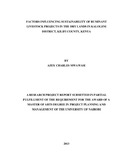| dc.description.abstract | This was a study on the factors influencing sustainability of ruminant livestock
projects in Kaloleni district, Kilifi County, Kenya. The study was carried out in July
covering the larger Kaloleni District. The study objectives were to investigate the
influences of water provision, provision of veterinary care, community involvement
in project planning and decision making, availability of adequate feeds throughout
the year, skilled animal husbandry human labor, and availability of ready market
for live animals and livestock products on sustainability of ruminant livestock
projects in dry lands of kaloleni. The design of the study was a descriptive survey
using questionnaires, observations as the main tools of data collection. The
researcher traversed all the 20 sub-locations of the district and four sub- location in
Rabai district, distributing and discussing the questionnaires as well as filling
them. The exercise lasted two weeks. At the end of this period the unfilled
questionnaires were left with the respondents and collected later. The population of
kaloleni was estimated to be 173,050 persons with 35,134 farm families. These farm
families formed target population for this study. To get ideal sample size,
(O’Leary,Z,2004),Formula was used. According to O’Leary, sampling is the
gathering and asking a range of individuals the same questions related to their
characteristics, attributes, how they live, or their opinions. It also involves formula for
calculating sample size as shown else- where in this report .Therefore the ideal sample
size for the research obtained was 380. This sample was randomly selected from 24
sub-locations by considering 15 respondents per sub-location and 2 respondents
per each sheep and goat group for the 10 groups studied. The 380 sample size
obtained was further sub-divided to form two samples that were studied separately.
One sample comprising of 185 respondents was used for study in high potential area,
designated as zone 1 and the other 195 respondents were for the dry lands; zone 2.
During the study 101 respondents turned up in zone 1 and 109 for zone 2; giving
response rates of 55% and 56% respectively. The study focused more on the dry lands.
Out of the six variables studied, five agreed with the research hypotheses and only one
on the availability of livestock feeds varied. The study found out that provision of
water, provision of veterinary care, community involvement in project planning and
decision making availability of skilled human labor and availability of a ready market
for live animals and livestock products had tremendous influence on the
sustainability of ruminant livestock projects in the dry lands of Kaloleni. It was
therefore recommended that concerted effort should be made by all the stake holders in
livestock development to address these variables in order to enhance sustainable
livestock production in kaloleni dry lands. Although the issue of feed availability did
not feature clearly as expected, there is need to re- vi sit it especially during the dry
season when livestock feed availability in this place is a night mare. Over reliance on
natural vegetation for feeding livestock, decreasing grazing land, degrading rangeland
and the changing climate is a big challenge that requires proper planning and
utilization of these resources. | en |

